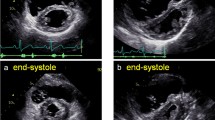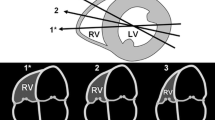Abstract
Background The accuracy of the guidelines of the American Society of Echocardiography (ASE) for the two-dimensional (2D) quantitative assessment of right ventricular (RV) size and function has not been evaluated against MRI-derived RV volumes in patients with congenital heart disease and RV volume overload. Methods Three groups of patients were studied: a normal RV group (Group I, n = 31), a repaired tetralogy of Fallot group (Group II, n = 33), and an unrepaired atrial septal defect and/or partially anomalous pulmonary venous connection group (Group III, n = 23). Recommended 2D linear and cross-sectional area measurements were made on clinical echocardiographic and MRI studies performed less than 6 months apart. Results Most 2D RV parameters were smaller by echocardiography versus MRI. There was weak correlation between 2D RV measurements by echocardiography and MRI-derived RV volumes (Group I: r = 0.15–0.54, Group II: r = 0.33–0.61, Group III: r = 0.32–0.85), and only modest improvement when the same 2D measurements were performed by MRI (Group I: r = 0.37–0.61, Group II: r = 0.44–0.69, Group III: r = 0.28–0.74). The difference between 2D RV measurements by echocardiography and MRI-derived RV volumes was more pronounced in the RV volume overload groups. Conclusions The correlation between currently recommended 2D RV measurements by echocardiography and MRI-derived RV volumes was weak, and improved only modestly when MRI was used to make the same 2D measurements. Moreover, 2D echocardiographic assessment of the RV appears to be less accurate in patients with congenital heart disease and a dilated RV.


Similar content being viewed by others
Abbreviations
- 2D:
-
Two-dimensional
- 3D:
-
Three-dimensional
- ASE:
-
American Society of Echocardiography
- BSA:
-
Body surface area
- MRI:
-
Magnetic resonance imaging
- RV:
-
Right ventricle or right ventricular
References
Voelkel NF, Quaife RA, Leinwand LA et al (2006) Right ventricular function and failure: report of a national heart, lung, and blood institute working group on cellular and molecular mechanisms of right heart failure. Circulation 114:1883–1891
Davlouros PA, Niwa K, Webb G, Gatzoulis MA (2006) The right ventricle in congenital heart disease. Heart 92(Suppl 1):i27–i38
Mendes LA, Dec GW, Picard MH, Palacios IF, Newell J, Davidoff R (1994) Right ventricular dysfunction: an independent predictor of adverse outcome in patients with myocarditis. Am Heart J 128:301–307
Ghio S, Gavazzi A, Campana C et al (2001) Independent and additive prognostic value of right ventricular systolic function and pulmonary artery pressure in patients with chronic heart failure. J Am Coll Cardiol 37:183–188
Lang RM, Bierig M, Devereux RB et al (2005) Recommendations for chamber quantification: a report from the American Society of Echocardiography’s Guidelines and Standards Committee and the Chamber Quantification Writing Group, developed in conjunction with the European Association of Echocardiography, a branch of the European Society of Cardiology. J Am Soc Echocardiogr 18:1440–1463
Foale R, Nihoyannopoulos P, McKenna W et al (1986) Echocardiographic measurement of the normal adult right ventricle. Br Heart J 56:33–44
Schenk P, Globits S, Koller J et al (2000) Accuracy of echocardiographic right ventricular parameters in patients with different end-stage lung diseases prior to lung transplantation. J Heart Lung Transplant 19:145–154
Beygui F, Furber A, Delepine S et al (2004) Routine breath-hold gradient echo MRI-derived right ventricular mass, volumes and function: accuracy, reproducibility and coherence study. Int J Cardiovasc Imaging 20:509–516
Maceira AM, Prasad SK, Khan M, Pennell DJ (2006) Reference right ventricular systolic and diastolic function normalized to age, gender and body surface area from steady-state free precession cardiovascular magnetic resonance. Eur Heart J 27:2879–2888
Kjaergaard J, Petersen CL, Kjaer A, Schaadt BK, Oh JK, Hassager C (2006) Evaluation of right ventricular volume and function by 2D and 3D echocardiography compared to MRI. Eur J Echocardiogr 7:430–438
Geva T (1997) Echocardiography and Doppler ultrasound. In: Garson A, Bricker JT, Fisher DJ, Neish SR (eds) The science and practice of pediatric cardiology, 2nd edn. Williams & Willkins, Baltimore
Lai WW, Geva T, Shirali GS et al (2006) Guidelines and standards for performance of a pediatric echocardiogram: a report from the task force of the Pediatric Council of the American Society of Echocardiography. J Am Soc Echocardiogr 19:1413–1430
Geva T, Sandweiss BM, Gauvreau K, Lock JE, Powell AJ (2004) Factors associated with impaired clinical status in long-term survivors of tetralogy of Fallot repair evaluated by magnetic resonance imaging. J Am Coll Cardiol 43:1068–1074
Alfakih K, Plein S, Thiele H, Jones T, Ridgway JP, Sivananthan MU (2003) Normal human left and right ventricular dimensions for MRI as assessed by turbo gradient echo and steady-state free precession imaging sequences. J Magn Reson Imaging 17:323–329
Lang RM, Mor-Avi V, Sugeng L, Nieman PS, Sahn DJ (2006) Three-dimensional echocardiography: the benefits of the additional dimension. J Am Coll Cardiol 48:2053–2069
Dell′Italia LJ (1991) The right ventricle: anatomy, physiology, and clinical importance. Curr Probl Cardiol 16:653–720
Haber I, Metaxas DN, Geva T, Axel L (2005) Three-dimensional systolic kinematics of the right ventricle. Am J Physiol Heart Circ Physiol 289:H1826–H1833
Helbing WA, Bosch HG, Maliepaard C et al (1995) Comparison of echocardiographic methods with magnetic resonance imaging for assessment of right ventricular function in children. Am J Cardiol 76:589–594
Jiang L, Levine RA, Weyman AE (1997) Echocardiographic assessment of right ventricular volume and function. Echocardiography 14:189–206
Kovalova S, Necas J, Vespalec J (2006) What is a “normal” right ventricle? Eur J Echocardiogr 7:293–297
Markiewicz W, Sechtem U, Kirby R, Derugin N, Caputo GC, Higgins CB (1987) Measurement of ventricular volumes in the dog by nuclear magnetic resonance imaging. J Am Coll Cardiol 10:170–177
Grothues F, Moon JC, Bellenger NG, Smith GS, Klein HU, Pennell DJ (2004) Interstudy reproducibility of right ventricular volumes, function, and mass with cardiovascular magnetic resonance. Am Heart J 147:218–223
Vogel M, Gutberlet M, Dittrich S, Hosten N, Lange PE (1997) Comparison of transthoracic three dimensional echocardiography with magnetic resonance imaging in the assessment of right ventricular volume and mass. Heart 78:127–130
Gopal AS, Chukwu EO, Iwuchukwu CJ et al (2007) Normal values of right ventricular size and function by real-time 3-dimensional echocardiography: comparison with cardiac magnetic resonance imaging. J Am Soc Echocardiogr 20:445–455
Nesser HJ, Tkalec W, Patel AR et al (2006) Quantitation of right ventricular volumes and ejection fraction by three-dimensional echocardiography in patients: comparison with magnetic resonance imaging and radionuclide ventriculography. Echocardiography 23:666–680
Hoch M, Vasilyev NV, Soriano B, Gauvreau K, Marx GR (2007) Variables influencing the accuracy of right ventricular volume assessment by real-time 3-dimensional echocardiography: an in vitro validation study. J Am Soc Echocardiogr 20:456–461
Acknowledgement
This study was supported in part by the Higgins Family Noninvasive Cardiac Imaging Research Fund.
Author information
Authors and Affiliations
Corresponding author
Rights and permissions
About this article
Cite this article
Lai, W.W., Gauvreau, K., Rivera, E.S. et al. Accuracy of guideline recommendations for two-dimensional quantification of the right ventricle by echocardiography. Int J Cardiovasc Imaging 24, 691–698 (2008). https://doi.org/10.1007/s10554-008-9314-4
Received:
Accepted:
Published:
Issue Date:
DOI: https://doi.org/10.1007/s10554-008-9314-4




